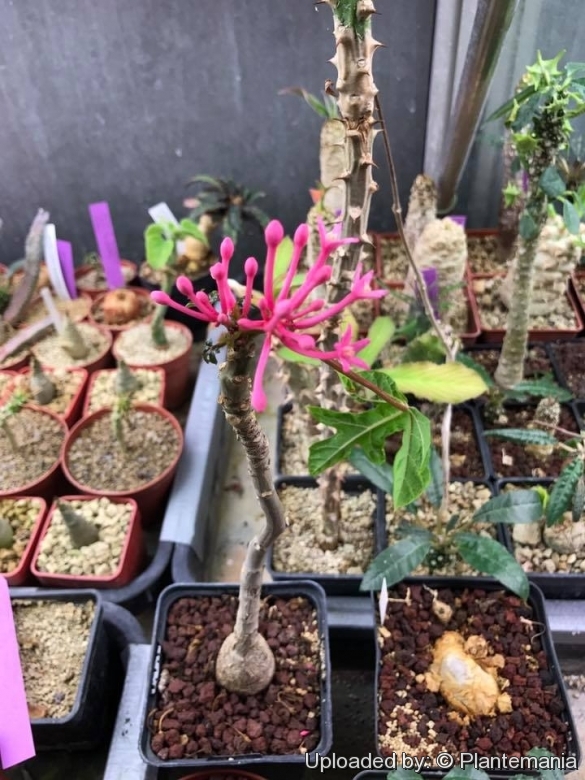
Carica parviflora Photo by: © Plantemania
: Carica parvifloraSN|33885]]SN|33885]] (Vasconcellea parvifloraSN|33887]]SN|33887]]) is endemic to the Pacific Andean slopes of Southern Ecuador and North Western Peru.
Habiatat and ecology: This species grows in semi-arid and arid places from sea level up to 1500 metres.
:
:
SPANISH (Español): coral, palo de yuca, sacha papaillo, papaillo, yuca de monte
: Carica parvifloraSN|33886]]SN|33885]] (often placed in genus Vasconcellea) is a large-leaved, deciduous pachycaul shrub to 50 cm tall or a small tree up to 2(-3) metres hight, frequently flowering when leaf-less. This species produces tiny bright orange fruit, stunning pink/purple flowers, but the fruits have very little edible flesh. Typically the young plants have a globose-elongate swelling at stem base, also known as a caudex. Carica parviflora is a dioecious species with female and male individuals. Both male and female flowers are morphologically similar to those of papaya (Carica papaya).
Stem: Usually simple unbranched, (except where it has been injured). The base of the trunk is globose-elongate and store water during drought, the bark is greyish, and smooth.
Leaves: Glabrous, lighter green beneath, 10-30 cm long, 6-25 cm wide, narrowly ovate to almost round in outline, appearing peltate by the overlapping sinuate lower lobes, basally cordate, irregularly 3-, 5-, 7- to 9-lobed, the lower lobes sometimes overlapping, all lobes obovate entire or again 3-lobed to pinnatilobed, acute to acuminate. Petiole 8-20 cm long.
Inflorescence: Paniculate, lax or contracted, 1-12 cm long, often pinkish. Male inflorescence long-peduncled, many-flowered, the pedicels 2 mm.
Flowers: Small and delicate bright pink/purple or rose-red coloured, calyx minute, corolla tube 8-13 mm long, more than 3 time as long as the lobes, villous within, the lobes 3-4 mm. long, ovate-oblong. Male flowers sessile or almost so (less than 2 mm), female flowers pedicellate 4-7 mm. Upper stamens apically 1-glandular, the connective of the anthers of the lower shortly produced.
Fruits: Small, 2-2.5 cm long, x 1-1.2 cm in diameter, narrowly ovoid, yellowish to reddish, porrect, of sweet-sour taste.
Seeds: Ovoid, 5-6 mm long.
Chromosome number: 2n = 2x = 18
Taxonomy notes: According to Solms-Laubach, Carica paniculataSN|33885]]SN|33886]] Spruce is distinguishable, from C. parviflora by the divergent lobes of the leaves, but the name C. paniculata is not accepted by many botanists that treat it as synonym.
: Major references and further lectures
1) Urs Eggli “Illustrated Handbook of Succulent Plants: Dicotyledons” Springer Science & Business Media, 2002.
2) Fieldiana: Botany, Volume 8, Part 4, Ed. 1;Volume 13, Part 4, Ed. 1 Field Museum of Natural History, 1941
3) Susanna Lyle “Fruit & nuts: a comprehensive guide to the cultivation, uses and health benefits of over 300 food-producing plants” Timber Press, 20 March 2006
4) SMITHSONIAN INSTITUTION
5) John L. Clark, David A. Neill and Mercedes Asanza “Floristic Checklist of the Mache-Chindul Mountains of Northwestern Ecuador” Contributions from the United States National Herbarium, Volume 54: 1-180 Department of Botany National Museum of Natural History Washington, DC 2006
6) Marina Iovene, Qingyi Yu, Ray Ming, and Jiming Jiang “Evidence for Emergence of Sex-Determining Gene(s) in a Centromeric Region in Vasconcellea parviflora” Genetics. 2015 Feb; 199(2): 413–421. Published online 2014 Dec 5. https://www.ncbi.nlm.nih.gov/pmc/articles/PMC4317651/
7) “Informe diversidad de frutales nativos comestibles caricaceae – Iniap” http://www.iniap.gob.ec/nsite/images/documentos/INFORMEDIVERSIDAD_FRUTALES_NATIVOS_COMESTIBLES_CARICACEAE_SOLANACEAE_FENOLOGIA_USOS_RECOLECCION_GERMOPLASMA_SUR_ECUADOR.pdf
 Carica parviflora Photo by: © Plantemania
Carica parviflora Photo by: © Plantemania
: Beloved by collectors, Carica parvifloraSN|33885]]SN|33885]] (Vasconcellea parvifloraSN|33887]]SN|33887]]) is cultivated mainly for its very striking rose-red blooms. It is an excellent caudiciform plant and it should make an interesting addition to a collection.










